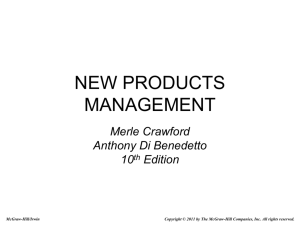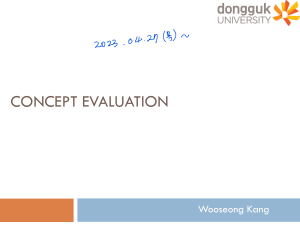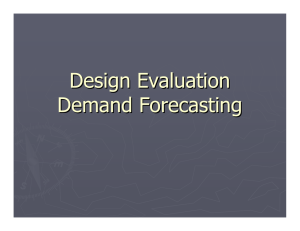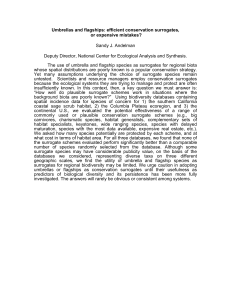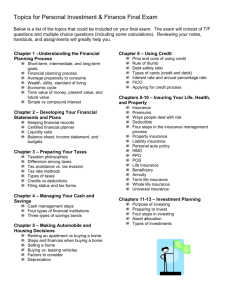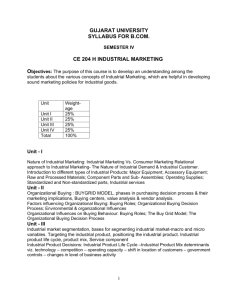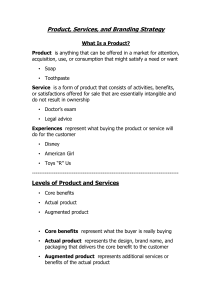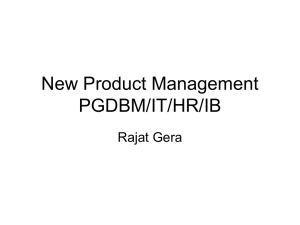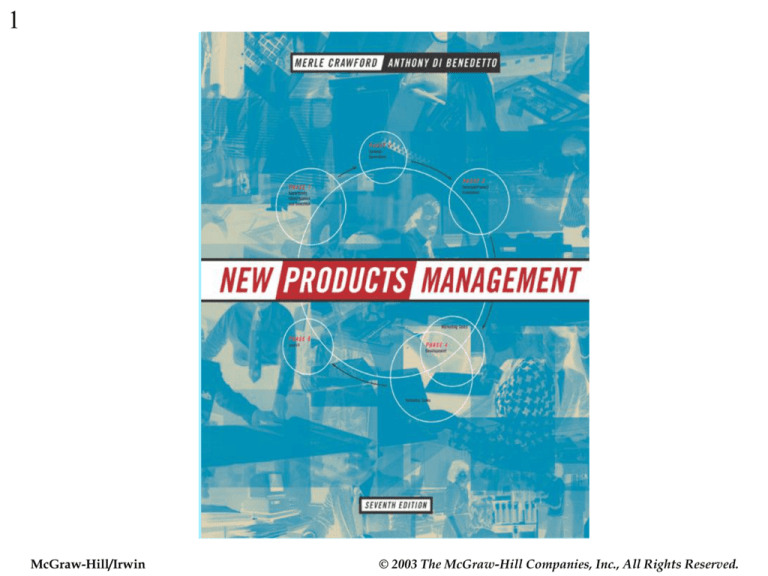
18-1
McGraw-Hill/Irwin
© 2003 The McGraw-Hill Companies, Inc., All Rights Reserved.
28-2
PART
THREE
CONCEPT/PROJECT
EVALUATION
38-3
Concept/Project Evaluation
Figure III.1
48-4
CHAPTER
EIGHT
THE CONCEPT
EVALUATION SYSTEM
58-5
The Evaluation System
Figure 8.1
68-6
Cumulative Expenditures Curve
Figure 8.2
% of
expenditures
Many high-tech
products
Many consumer
products
Time
Launch
78-7
Risk/Payoff Matrix at Each
Evaluation
Decision
A
Stop the Project Now
B
Continue to Next Evaluation
A. Product would fail if
marketed
AA
BA
B. Product would succeed if
marketed
AB
BB
• Cells AA and BB are “correct” decisions.
• Cells BA and AB are errors, but they have
different cost and probability dimensions.
Figure 8.3
88-8
Planning the Evaluation
System: Four Concepts
• Rolling Evaluation (tentative nature of new
products process)
• Potholes
• People
• Surrogates
98-9
Rolling Evaluation (or,
"Everything is Tentative")
• Project is assessed continuously (rather than a single
Go/No Go decision)
• Financial analysis also needs to be built up continuously
• Not enough data early on for complex financial analyses
• Run risk of killing off too many good ideas early
• Marketing begins early in the process
• Key: new product participants avoid "good/bad"
mindsets, avoid premature closure
8-10
10
Potholes
Know what the really damaging problems
are for your firm and focus on them when
evaluating concepts.
Example: Campbell Soup focuses on:
• 1. Manufacturing Cost
• 2. Taste
8-11
11
People
• Proposal may be hard to stop once there
is buy-in on the concept.
• Need tough demanding hurdles, especially
late in new products process.
• Personal risk associated with new product
development.
• Need system that protects developers and
offers reassurance (if warranted).
8-12
12
Surrogates
• Surrogate questions give clues to the
real answer.
Real Question
Will they prefer it?
after
Will cost be competitive?
Will competition leap in?
Will it sell?
Surrogate Question
Did they keep the prototype
product we gave them
the concept test?
Does it match our
manufacturing skills?
What did they do last time?
Did it do well in field testing?
8-13
13
An A-T-A-R Model of Innovation
Diffusion
Figure 8.5
Profits = Units Sold x Profit Per Unit
Units Sold = Number of buying units
x % aware of product
x % who would try product if they can get it
x % to whom product is available
x % of triers who become repeat purchasers
x Number of units repeaters buy in a year
Profit Per Unit = Revenue per unit - cost per unit
8-14
14
The A-T-A-R Model: Definitions
Figure 8.6
• Buying Unit: Purchase point (person or
department/buying center).
• Aware: Has heard about the new product with
some characteristic that differentiates it.
• Available: If the buyer wants to try the product,
the effort to find it will be successful (expressed
as a percentage).
• Trial: Usually means a purchase or consumption
of the product.
• Repeat: The product is bought at least once
more, or (for durables) recommended to others.
8-15
15
A-T-A-R Model Application
10 million
players
x 40%
x 20%
Number of owners of Walkman-like CD
Percent awareness after one year
Percent of "aware" owners who will try
product
x 70%
Percent availability at electronics retailers
x 20%
Percent of triers who will buy a second unit
x $50
Price per unit minus trade margins and
discounts ($100) minus unit cost at the
intended volume ($50)
= $5,600,000 Profits
8-16
16
Model
1. Each factor is subject to estimation.
Estimates improve with each step in the development
phase.
2. Inadequate profit forecast can be improved by
changing factors.
If profit forecast is inadequate, look at each factor and
see which can be improved, and at what cost.
8-17
17
Getting the Estimates for
A-T-A-R Model
Item
Market Units
Awareness
Trial
Availability
Repeat
Consumption
Price/Unit
Cost/Unit
Market
Research
XX
Concept Test
X
X
XX
Product Use
Test
X
X
X
X
X
XX
X
X
Component
Testing
X
X
X
X
XX: Best source for that item.
X: Some knowledge gained.
X
X
Figure 8.7
Market Test
X
X
X
XX
X
XX
XX
XX

